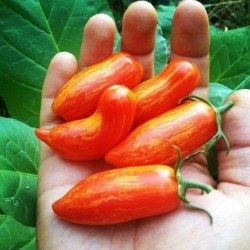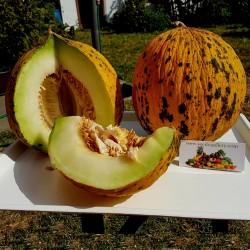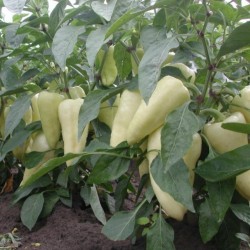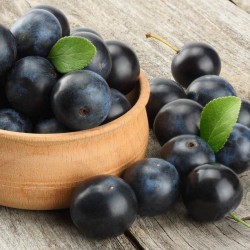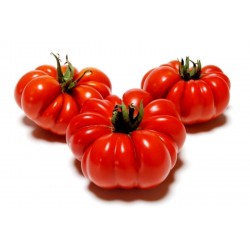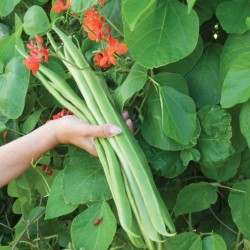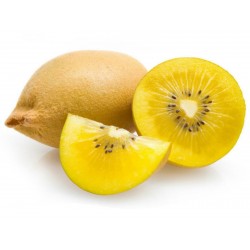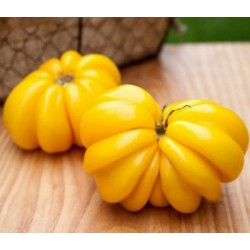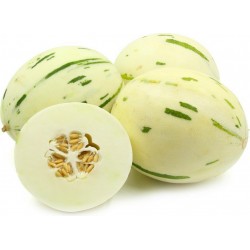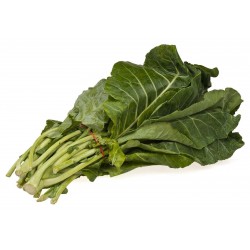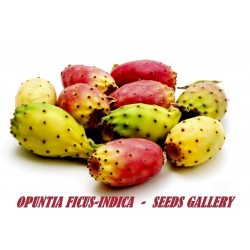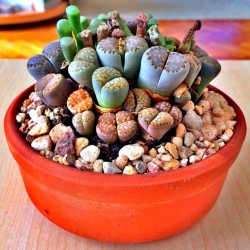Seeds Gallery Com,
5/
5
<h2><strong>Semena Trnka obecná (Prunus spinosa)</strong></h2>
<h2><span style="color: #ff0000;"><strong>Cena za balení 10 semen.</strong></span></h2>
<p><b>Trnka obecná</b><span> (</span><i>Prunus spinosa</i><span>) neboli </span><b>slivoň trnka</b><span>, někdy </span><b>slivoň trnitá</b><span>, je listnatý keř, řidčeji malý strom, pocházející z </span>Evropy<span>, </span>Asie<span> a severní </span>Afriky<span>. Patří do čeledi </span>růžovitých<span> (</span><i>Rosaceae</i><span>).</span></p>
<p>Trnka obecná je hustý rozložitý<span> </span>keř<span> </span>dosahující obvykle výšky 2 metry. Ve výjimečných případech může ovšem dosáhnout až 5 metrů. Kmínky rostou pomalu a odumírají již po 20 – 40 letech.<sup id="cite_ref-rfr3_2-0" class="reference">[2]</sup></p>
<p>Na větvích se nacházejí trnovité výběžky tmavošedé barvy –<span> </span>kolce, vznikající přeměnou postranních větviček. Mladé větve jsou zelené a ochlupené. Později mají větve červenohnědou až tmavě šedohnědou barvu, jsou velice tvrdé a houževnaté.<span> </span>Pupeny<span> </span>jsou krátce brvité, kulovitého tvaru.<sup id="cite_ref-rfr1_3-0" class="reference">[3]</sup></p>
<p>Listy<span> </span>jsou 2 – 4 cm dlouhé a 1 – 2 cm široké. Vyrůstají na 2 – 10 mm dlouhých<span> </span>řapících, které mohou být mírně ochlupeny. Jejich<span> </span>čepel<span> </span>je oválná až podlouhle vejčitá. Jsou tupé, někdy také přišpičatělé, zakončeny jsou klínovitou bází. Mohou být lysé, nebo na spodní straně, zejména na žilnatině, chlupaté. Okraj<span> </span>čepele<span> </span>bývá vroubkovaně zubatý. Na větvích vyrůstají<span> </span>listy<span> </span>střídavě, často jsou uspořádány spirálovitě. Zpravidla raší až po odkvětu.<sup id="cite_ref-rfr2_4-0" class="reference">[4]</sup></p>
<h3><span id="Kv.C4.9Bt_a_plod"></span><span class="mw-headline" id="Květ_a_plod">Květ a plod</span></h3>
<p>Bílé stopkovité pětičetné<span> </span>květy<span> </span>se vytvářejí již brzy na jaře, u nás zejména v březnu a dubnu. Mají průměr až 1,5 cm. Mohou vyrůstat jednotlivě, většinou je však nalezneme v převislých<span> </span>okolících. Skládají se z 5 na spodu trochu srostlých, 2 mm dlouhých<span> </span>kališních lístků<span> </span>se žláznatými zoubky, 5 vejčitých, 5 – 8 mm dlouhých<span> </span>korunních lístků, cca 20 tyčinek a pestíku. Uvnitř<span> </span>květu<span> </span>je produkováno velké množství<span> </span>nektaru<span> </span>sloužícího jako potrava pro<span> </span>opylovače.<sup id="cite_ref-rfr1_3-1" class="reference">[3]</sup></p>
<p>Z oplodněných<span> </span>květů<span> </span>se na krátké, relativně tlusté plodní stopce vyvíjejí kulovité<span> </span>peckovice<span> </span>o velikosti 10 – 15 mm –<span> </span>trnky, někdy označované také jako prunélky. Zpočátku je zelená, po dozrání je modročerná a je ojíněná voskovou vrstvou. Dužina si zachovává zelenou barvu.<sup id="cite_ref-5" class="reference">[5]</sup><span> </span>Ve středu<span> </span>plodu<span> </span>je asi 9 mm dlouhá a 6 mm široká<span> </span>pecka<span> </span>obsahující semeno. Okolní dužina je od ní pouze těžce oddělitelná.<span> </span>Plody<span> </span>dozrávají od října do listopadu a zůstávají na rostlině přes celou zimu. Chutnají trpce kysele, chutnější jsou až po přejití mrazem.</p>
<h2><span id="Stanovi.C5.A1t.C4.9B_a_v.C3.BDskyt"></span><span class="mw-headline" id="Stanoviště_a_výskyt">Stanoviště a výskyt</span></h2>
<div class="thumb tright">
<div class="thumbinner"><img alt="Semena Trnka obecná (Prunus spinosa)" src="https://upload.wikimedia.org/wikipedia/commons/thumb/3/3d/Prunus_spinosa_range.svg/220px-Prunus_spinosa_range.svg.png" decoding="async" width="220" height="137" class="thumbimage" srcset="//upload.wikimedia.org/wikipedia/commons/thumb/3/3d/Prunus_spinosa_range.svg/330px-Prunus_spinosa_range.svg.png 1.5x, //upload.wikimedia.org/wikipedia/commons/thumb/3/3d/Prunus_spinosa_range.svg/440px-Prunus_spinosa_range.svg.png 2x" data-file-width="1418" data-file-height="886" title="Semena Trnka obecná (Prunus spinosa)" />
<div class="thumbcaption">
<div class="magnify"></div>
Oblast rozšíření trnky obecné</div>
</div>
</div>
<p>Optimální podmínky nachází trnka v suboceánském klimatu.<sup id="cite_ref-rfr2_4-1" class="reference">[4]</sup><span> </span>Vyskytuje se převážně na sušších stanovištích s vápnitou půdou. Často ji proto nalezneme na kamenitých stráních, mezích, slunných skalách, suchých pastvinách i světlých listnatých lesích.<sup id="cite_ref-rfr3_2-1" class="reference">[2]</sup><span> </span>Je velice odolná vůči suchu a mrazu.</p>
<p>Trnka je rozšířená od nížin až do horského pásu po celé<span> </span>Evropě. Na východ je rozšířená až do<span> </span>Íránu<span> </span>a<span> </span>Zakavkazí. V severních částech<span> </span>Evropy<span> </span>ji nalezneme až po města<span> </span>Bergen<span> </span>(Norsko) a<span> </span>Uppsala<span> </span>(Švédsko). Areál jejího rozšíření zahrnuje i severní<span> </span>Afriku. V<span> </span>Severní Americe<span> </span>se vyskytuje pouze jako nepůvodní zplanělý druh, především ve východní části.<sup id="cite_ref-rfr1_3-2" class="reference">[3]</sup></p>
<h2><span class="mw-headline" id="Ekologie">Ekologie</span></h2>
<p>Díky svým dlouhým kořenům, tvořícím mnoho výhonů, a vysoké odolnosti vůči nehostinným podmínkám vyniká trnka v obsazování nových stanovišť, ze kterých vytěsňuje bylinnou vegetaci. Často vytváří rozsáhlé houštiny.<span> </span>Plody<span> </span>trnky jsou pro ptactvo v zimním období významným zdrojem potravy. Ekologicky vázána na její výskyt je také celá řada druhů<span> </span>motýlů. Mnozí ptáci ji vyhledávají pro hnízdění. Tímto chováním je typický například<span> </span>ťuhýk.<sup id="cite_ref-6" class="reference">[6]</sup></p>
<h2><span id="Vyu.C5.BEit.C3.AD"></span><span class="mw-headline" id="Využití">Využití</span></h2>
<p>U trnky jsou často využívány zejména<span> </span>plody, které slouží jakožto základní surovina pro výrobu ovocného vína a<span> </span>pálenky. Využívány jsou také k ochucování likérů, zejména v severských zemích.<span> </span>Trnky<span> </span>jsou vhodné také ke konzervaci a výrobě<span> </span>džemů. K přímé konzumaci v syrovém stavu jsou vhodné až po přejití mrazem. Tohoto efektu lze dosáhnout také umělým zmrazením. Dříve se šťáva z trnek využívala také k barvení látek, kterým po několikanásobném vyprání dávala trvalou světle modrou barvu.<span> </span>Přadleny<span> </span>v historii žvýkaly<span> </span>trnky<span> </span>pro podporu tvorby<span> </span>slin, které využívaly k vlhčení niti při<span> </span>předení.<sup id="cite_ref-rfr1_3-3" class="reference">[3]</sup></p>
<p>Tradičně je trnka považována za léčivou rostlinu. Využívá se zejména<span> </span>květů, které působí diureticky. Užívá se také při poruchách trávení a průjmech.</p>
<p>Dřevo trnky je velice těžké a tvrdé. Má hnědočervené jádro a načervenalou běl. Je vhodné k soustružení. Často se využívá pro výrobu holí.<sup id="cite_ref-rfr3_2-2" class="reference">[2]</sup></p>
<p>Jejích růstových vlastností se využívá zejména na různých svazích a náspech, které díky svému rozsáhlému kořenovému systému dokáže efektivně zpevnit. Tradičně bývá vysazována také jako hranice pro zadržování dobytka, před kterým je chráněna díky svým ostrým<span> </span>kolcům<span> </span>a tuhým větvím.</p>
<p>Byla používána jako podnož, ale má množství výmladků. Jako podnož jsou používány některé vegetativně množené klony kříženců s jinými slivoněmi, jako například Jaspi (syn. Fereley) nebo GF 1869.<sup id="cite_ref-7" class="reference">[7]</sup></p>
<script src="//cdn.public.n1ed.com/G3OMDFLT/widgets.js"></script>
V 156 (2.5g)




